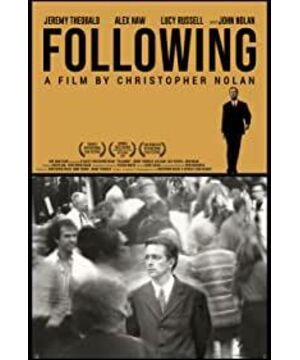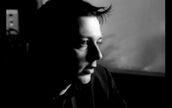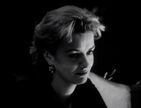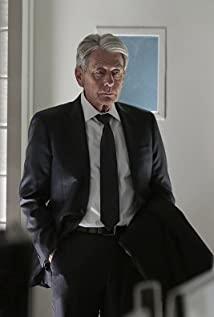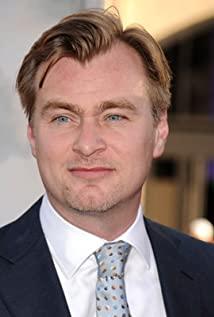"Following" is director Christopher Nolan's feature-length debut. The film is only 69 minutes long. It was released at the San Francisco Film Festival in 1998. This small-cost independent film with a production cost of only $6,000 brought Nolan to the Hollywood front line.
The story is about a boring person who stalks others, but is framed as a scapegoat by others. Peel off the mysterious narrative and other film techniques, analyze the protagonist's perverted behavior from "stalking" to "peeping", reach his deep inner fear, and see how Nolan handles the complex relationship between behavior and psychology.
Narration and Cross-Editing, Unbelievable Movies
"Here's my explanation, or statement of the facts. I've been living alone for quite a while, feeling increasingly lonely and bored, with nothing to do all day long. So I start stalking. That's stalking, I start stalking people."— — Bill
Narration is a simple and characteristic expression that is rarely used well in movies these days. Bill's two or three simple sentences at the beginning of "Following" bring us into context. The ordinary motive "boring", combined with the unusual action "stalking", forms the "hook" of the film.
At the same time, narration can make the authenticity of the story questionable, or have a satirical effect. For example, the three images of Bill intersect, forming a non-linear narrative. It is impossible to judge whether the speaker is credible or not, and it is impossible to judge the chronological order. Only props can connect the fragments of the picture. This is a technique that Nolan often uses in subsequent films.
In addition to the narration effect, the biggest reason for Nolan's choice of narration is that the sound quality of the on-site radio is poor, and the narration recorded in 5 minutes can buy time for the story. When the film festival judges realize that the sound quality is not good, they have already been drawn by the story. went away.
The use of light and shadow also affects the authenticity of the narrator. Low-cost black-and-white films highlight light and shadow more than color. Light and dark contrasting lighting enhances the dramatic element of light. At least 3/4 of Bill's face is visible, but only 1/2 of the policeman's face, and the other half of the policeman's face has never been seen. It implies that Bill's credibility is higher than that of the police. Later, Cobb also said that if the police identify the criminal, they will find a way to convict.
The scene of Bill and the police, and the dark bar use low-key lighting, with a large contrast between light and shadow, which emotionally renders a tense and depressed atmosphere. The stolen room, the room of Bill and the blond woman, and the cafe are all high-key lighting, that is, the scene has sufficient brightness. Nolan once mentioned in an interview that fill lights were used to shoot indoor scenes, in order to make the light better, Actors always go to the window when they say their lines.
Light affects whether details can be seen, such as the Batman logo on Bill Gate, Marilyn Monroe on the wall.
In addition, the role played by Leonardo in "Inception" many years later is also called Cobb, which shows Nolan's ingenuity.
There are many imagery in the film, the box symbolizing inner secrets, voyeuristic photos, and fetish underwear, among which the image of the door appears extremely frequently, but is less discussed. Perhaps because the door cannot be considered a detail, it is too common and easy to be ignored.
The door of the bar has a special style. At first glance, only a black hole can be seen. For Bill, the bar was where he first met the blond woman, when he first fell into the trap, when he was still just a conspiracy. And the last time he went to the bar, he wounded the night watchman and became the real criminal. I went in and out of this door several times, and it turned out to be earth-shaking when I came out.
I think this door symbolizes the passage to a bottomless pit-like heterogeneous space. Bill went from stalking others to setting fire to his body. It seems that he picked the wrong object, but he didn't know the object was picking him, and then led him into the "snake hole" ". What happened in the "hole" is true and false, no one can tell.
Hollywood Stranger Nolan: The special effects you think are not special effects
British director Nolan took his first "child" to the United States to participate in the film festival. He was appreciated and gradually became a Hollywood first-line director. In this low-budget film, even the actors are not professional. Bill and Cobb, who are both Nolan's friends, negotiated a 15-minute free time every weekend, and filmed for about a year.
Usually, filming takes several months to focus on shooting, and there are too many inconveniences in intermittent shooting, especially when a scene and props are set up and shot, it is difficult to completely restore the shot, and it is very easy to wear. The fragmented cross-cutting just makes up for this shortcoming.
The performance of non-professional actors can be said to be amazing and spiritual. Jeremy Theobald, who played Bill, filmed a two-minute short film "Antflies" with Nolan a year before "Following". In the form of a black and white silent film, a circular space of "I shoot myself to death" is outlined, in which Jeremy's anxiety is very expressive. And Alex Ho, who plays Cobb, "Follow" is his only work, is now an architect and a crossover artist.
Shortly after filming "Follow", Nolan began planning his next work, "Memento." The extremely similar cross-editing technique disrupts the linear narrative and "reverses" the entire film to a certain extent.
Such a technique has been successful in "Following", and in "Memento", Nolan is even more at ease. The difference is that the former allows us to “follow” suspiciously from the perspective of a voyeur, but fortunately the clues are clear; the latter uses the more common detective perspective to improve the credibility of the narrator, but it is too fragmented. The clues increase the difficulty, so that when we are finally "betrayed" by the hero, we will doubt our IQ.
Nolan played with the form, and he also made great efforts in the selection of props. In order to make the picture more realistic, he used less special effects. In "Batman", a hospital was really blown up; in "Inception", the dream collapsed, and on the basis of protecting the safety of the actors, blasting points were set up around it.
In "Dunkirk", Nolan did not need a swimming pool, but directly soaked in the sea to shoot; the five-dimensional space of "Interstellar" was actually built.
It is said that Nolan's new film "Creed" tentatively scheduled to be released in July this year has a scene that needs to blow up the plane, so he asked the crew to buy a batch of old Boeing 747s to blow up. Under the technology that can be achieved by special effects or models, Nolan still adheres to the traditional film techniques and the authenticity of the picture, which shows the degree of attention to the film.
What are we talking about when we talk about "peeping"
All along, Nolan's works have shown his adherence to the "author theory". The core of the "author theory" is that the author of a film is the director. And to be the real leader of the work, it is necessary to take the film as the person who "externalizes the inner world".
It is precisely this point that there are fewer and fewer real filmmakers. When the film is no longer to express a certain idea, a certain deepened emotion, the film becomes a popular tool for mass entertainment. But Nolan's existence, from "Dunkirk" back to "Following", shows his thoughts, inner emotional world, and the complexity behind trying to understand the behavior of "people".
As early as the first film, Nolan showed the complexity of the characters and a strong sense of tragedy, inserting elements of criminal psychology, which may be the reason why many people misinterpreted it as schizophrenia.
Dissecting Bill's stalking behavior stems from his voyeuristic desire, not just "boring" or "curious about people." With his withdrawn and weak personality, he could not normally establish emotional connections with others to satisfy his "curiosity" instinct, so he passively chose to follow and peep, and he was satisfied in the process of trial and error without being discovered. From a criminal point of view , the pleasure needs to be upgraded.
The behavior reflects the heart. The tragedy of Bill's image is that he didn't know whether he chose the wrong object, or whether Cobb had already followed Bill and deliberately led him to follow him back. Either way, the stalking action was not accidental, and his fear of having no place in society, coupled with the thrill of voyeurism, made him a real "voyeur". Doomed to tragedy.
This also explains why they broke into the first family's house, instead of stealing valuables, they only messed up their "boxes" and picked souvenirs to take away. Since neither of them are thieves driven by materialistic desires for power, the pleasure of voyeurs lies in seeing other people's secrets. A stolen house is like a "box", which belongs to the private domain of others. And when the hostess came home, Bill panicked and fled the fear, because he knew that this kind of behavior was not allowed, but he couldn't control it next time.
Nolan said of "Following," "Characters are defined by their actions, their interactions with each other, their fears, their lives, their relationships. Great film noirs are built on those fears."
When we're talking about voyeurism, we're talking about the complex relationship between external behavior and deep fear, which I think Nolan is trying to convey in "Following."
This article was first published on [Preferred Film and TV Drama Materials], come and see more of my film reviews~
View more about Following reviews


